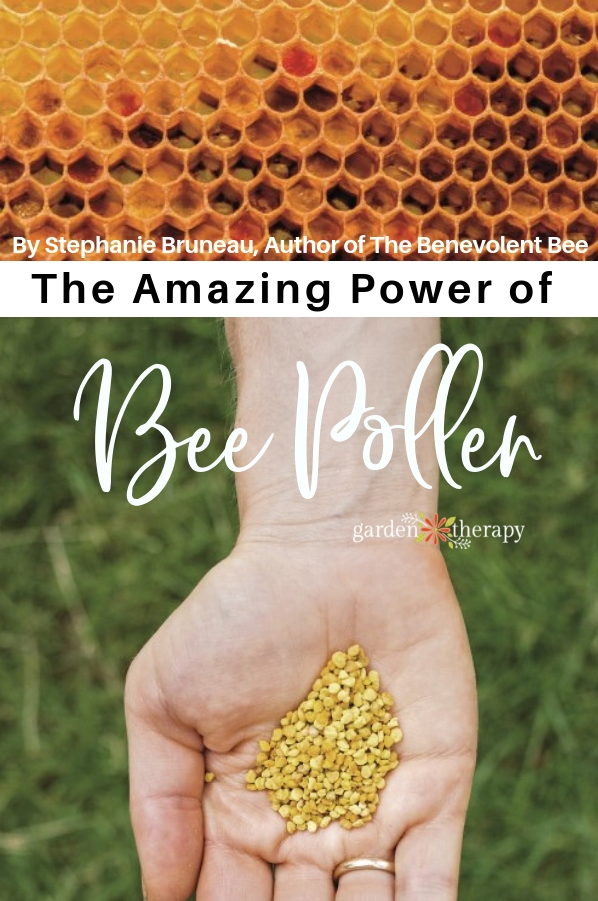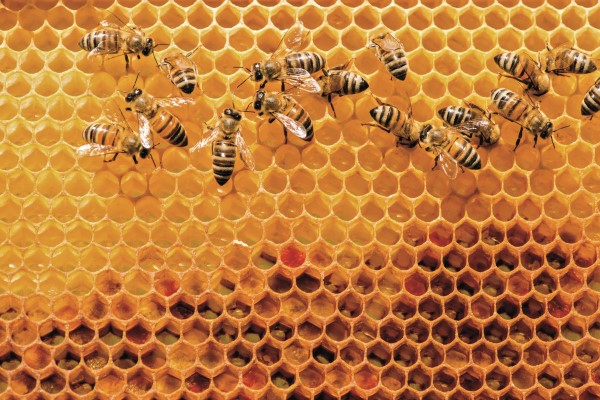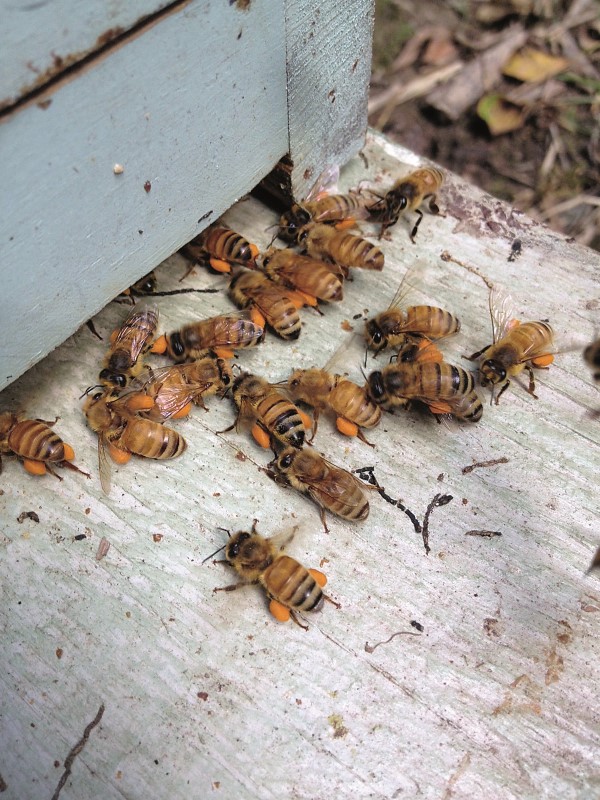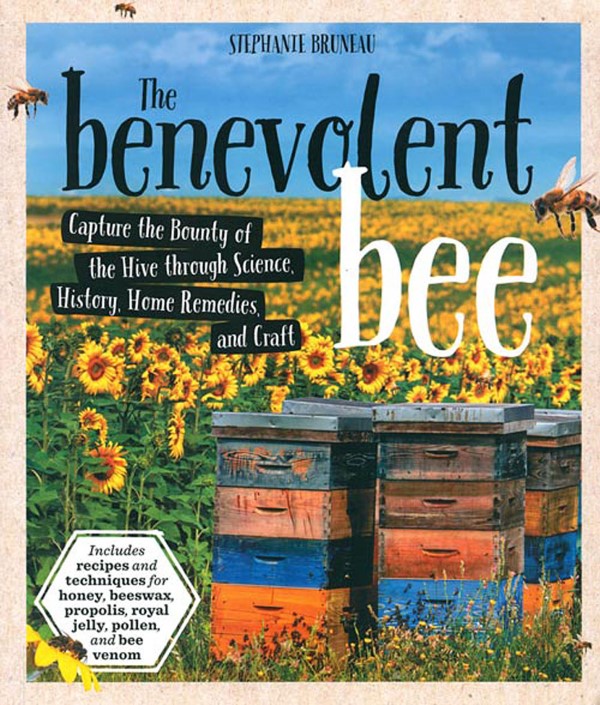I hear a lot about bee pollen lately as a superfood ingredient and a health supplement, but what exactly is it? And what does it do? Bee pollen has a whole host of amazing health benefits. The Benevolent Bee herself, Stephanie Bruneau, is here today to teach us all about how bee pollen is made and why it matters.

For more great information on bees and bee products, you’ve got to check out Stephanie’s fabulous book The Benevolent Bee: Capture the Bounty of the Hive through Science, History, Home Remedies, and Craft.
What is Pollen?
By Stephanie Bruneau
Pollen is a flower’s way of making more flowers. Grains of pollen are a plant’s male sex cells, and wind or insects carry the grains from one flower to another, ensuring genetic diversity. Certain flowering plants have developed in a way that’s attractive and beneficial to bees in a process of coevolution. The plants provide nutrient-rich pollen and sweet nectar, and in turn, the bees’ hairy bodies and behaviors efficiently transfer pollen from flower to flower.
When forager bees leave the hive to collect pollen, they are very faithful to one type of flower on each visit, never visiting different flowering plants on the same trip. This evolutionary adaptation means that bees will bring apple blossom pollen to another apple blossom, where it is needed for pollination, and not a rose, where it will do no good. It also means that each pollen granule that bees bring back to the hive is uniform in color. Looking at a collection of pollen granules reminds me of looking closely at sand. From a distance, the varied colors and textures of the grains blend together, but close up it’s easy to see a wide range of colors.

Pollen is important for plants, but it’s also crucial for bees. Pollen is the source of all protein, fat, vitamins, and trace elements in the honeybee’s diet, and it is fed to both the adult bees in the hive as well as the developing larvae. Because the queen can lay up to 1,500 eggs a day in the early summer, there can be as many as 30,000 (!) developing larvae requiring protein to grow into bees. In one year, a hive of bees consumes about 75 pounds (34 kg) of pollen. It takes approximately one million collection trips out of the hive to gather this annual supply.
Bees collect pollen on separate trips from nectar-collecting excursions, visiting flowers that have the most nutritious and easiest to collect pollens, which can be different from the best flowers for collecting nectar. On each trip from the hive, a forager bee collecting pollen will visit between ten and one hundred flowers, and will make up to twenty trips per day. With forelegs moistened with saliva, she combs the pollen that collects on her fuzzy body and pushes it into a tiny cavity on the outside of each hind leg. The saliva and a bit of nectar moisten the pollen grains and help them keep together, and the tiny hairs on the bee’s leg help hold the granule in place.

Back in the hive, house bees help the foragers unload the pollen into cells of honeycomb. These house bees further mix the pollen with more saliva (containing enzymes from the bee’s stomach) and nectar. These added ingredients start breaking down and fermenting the pollen, making it digestible for the bees. At this stage, the pollen has been turned into the super nutritious, probiotic staple of the honeybee’s diet, “bee bread.”
Pollen for Nutrition, Health, and Wellness
C. Leigh Broadhurst, an expert in environmental remediation and trace elements in the environment and food supply, said, “All of the health benefits you’ve ever heard attributed to plant foods—from blueberries to broccoli to garlic—can be contained in a single pollen basket.” Indeed, Broadhurst is right. It is a bit of an understatement to simply say that pollen is highly nutritious. Pollen is full of an alphabet of vitamins and every trace element known to be essential for mammals (although some are present in very small amounts). Pollen also contains eleven enzymes and coenzymes; fourteen fatty acids; and several potent phytochemicals (plant-derived chemicals), specifically carotenoids and phenolics such as flavonoids and phytosterols, valued for their antioxidant properties.

Pollen contains 12 to 40 percent protein by weight (depending on the pollen source), and unlike most plant-based proteins, it has a full spectrum of amino acids, making its protein balanced and complete.
Chock-full of these nutritious and health-boosting elements, pollen has been found to be helpful in so many ways:
Athletes (and tired parents) can use pollen to boost energy and stamina. The flavonoids in pollen can help lower cholesterol and reduce inflammation, helping prevent heart disease. Strongly antioxidant, pollen can help neutralize the free radicals that damage the cells in our bodies.
The wide range of nutrients and trace elements found in pollen helps boost overall health and immunity. Pollen contains the phytochemical rutin, which strengthens blood vessels and capillaries. This can help with varicose veins, hemorrhoids, and hypertension.

Several scientific studies have shown pollen to be useful in treating chronic prostatitis (inflammation of the prostate gland).
Pollen contains lecithin, which is used medically for treating high cholesterol, anxiety, and memory disorders such as dementia and Alzheimer’s disease. Lecithin is also used to help control body weight. Eaten before a meal, pollen can help boost metabolism and minimize food cravings.
Printed with permission from The Benevolent Bee: Capture the Bounty of the Hive through Science, History, Home Remedies, and Craft by Stephanie Bruneau © 2017. Published by Quarry Books. Photography courtesy of Quarry Books.
About the Author
Stephanie Bruneau is a beekeeper, environmental educator, amateur herbalist, artist, homemaker, and mama to two junior beekeepers in training. She is passionate about bees, natural living, and raising healthy, creative, and happy kids. Together with her husband, Emile, Stephanie runs The Benevolent Bee, a small business selling honey, beeswax candles, herbal body care products, and other handcrafted and hive-derived items. At the Benevolent Bee “Teaching Apiary” Stephanie observes, learns, and teaches about bees and bee behavior to students of all ages.





Great article! I loooove bee pollen. Anyone interested in this stuff should definitely check out the book Everyday Roots. It teaches you how to replace all the toxic chemicals in your life with healthy organic alternatives. Its completely changed my life and how I feel everyday! :)
Keep up the great content!
My concern is what the bees do without the pollen removed? It takes so many trips by bees to make it.
I kept reading and expecting to learn how the pollen is collected for our consumption, but nothing. So, how is it collected? I worry about the health of our bee communities in a time when it seems they are so challenged.